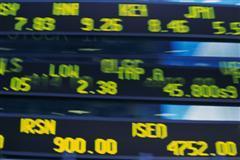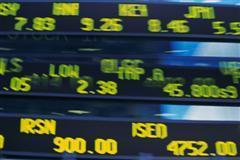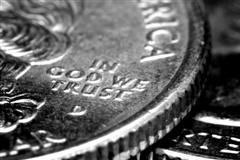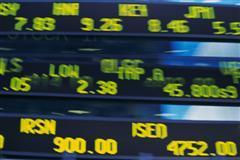| Home | About | Archives | RSS Feed |

@theMarket: Overhead Resistance Keeps Markets in Check
 "I don't get it," gripes an investor who called from Chicopee, "Congress goes and passes the tax-cut extensions, which is good news, right, and still the market does nothing. What gives?"
"I don't get it," gripes an investor who called from Chicopee, "Congress goes and passes the tax-cut extensions, which is good news, right, and still the market does nothing. What gives?"
By way of explanation, pundits argue that the passage of this event was already "baked in" to the averages, which is why the markets are trading close to the year's high. OK, I'll take that on board but there has been a lot of good news lately that should not have been discounted — higher consumer confidence, less unemployment, greater factory output — but the market appears uninterested. The much-heralded Christmas rally has stalled just below a key resistance area at 1,250 on the S&P 500 Index. So maybe we have hit the highs for this year already.
Last week, I wrote that it wouldn't surprise me if we saw a 50-75 point pullback in the S&P Index. I opinioned that the catalyst might be a congressional failure to pass the tax cut extensions. Although the extensions were passed, the markets still look like they would rather go down than up in the short term.
That is surprising since my friend in Chicopee is right. The latest government initiative could add somewhere between 0.50 percent to 1 percent to 2011 GDP. That is nothing to sneeze at so maybe fundamental analysis is not the place to look for an answer.
Technically most stocks, sectors and commodities are overextended. In order to correct that condition, the averages need to back and fill for a period of time or a market pullback is in order.
In addition, whenever markets approach a big technical area of resistance like 1,250, there is usually a battle of wills between the bulls and the bears. So why is 1,250 such an important number?
Readers may recall that by September 2008, Bear Sterns had already collapsed as had Fannie Mae and Freddie Mac, our two quasi-governmental mortgage giants. The House of Lehman Brothers was about to fall and that's when the S&P first broke 1,250 (on Sept. 3). It traded back and forth with a great deal of volatility around that level until Sept. 23 when it finally gave up the ghost and plummeted 48 points. Suffice it to say that the 1,250 level was not easily conceded by the bulls and what had once served as strong support for the markets, once broken, now also serves as an important resistance point in the index's attempt to move higher.
The process of testing that resistance level is what is occurring right now. My guess is that the bulls will ultimately win that struggle but not without a fight. I do not believe we will see the massive percentage point swings that we suffered through in 2008 but a milder, less dramatic give and take that could last for another week or so.
Whether the ongoing problems within the European financial sector will furnish the excuse the bears will need for a pullback remains to be seen. Higher interest rates over in the government bond market or a big move in the dollar could also spook investors. Regardless of the reason, I would be adding equity to my portfolio on any dip.
Bill Schmick is an independent investor with Berkshire Money Management. (See "About" for more information.) None of the information presented in any of these articles is intended to be and should not be construed as an endorsement of BMM or a solicitation to become a client of BMM. The reader should not assume that any strategies, or specific investments discussed are employed, bought, sold or held by BMM. Direct your inquiries to Bill at 1-888-232-6072 (toll free) or e-mail him at wschmick@fairpoint.net. Visit www.afewdollarsmore.com for more of Bill's insights.
| Tags: market, swings, bulls |
The Independent Investor: Why Are Interest Rates Rising?
 U.S. Treasury bond interest rates are rising. Since August, the yield on the 30-year bond has risen over one percent, the 10-year is up 118 basis points and the five year is up 102 basis points. For those unfamiliar with the government bond market these are moves akin to the stock market rising 50 percent.
U.S. Treasury bond interest rates are rising. Since August, the yield on the 30-year bond has risen over one percent, the 10-year is up 118 basis points and the five year is up 102 basis points. For those unfamiliar with the government bond market these are moves akin to the stock market rising 50 percent.
It wasn't supposed to happen this way. The Federal Reserve Bank's second quantitative easing (QEII) was meant to keep interest rates low, provide even more liquidity to the markets and, hopefully, convince banks to lend more to cash-strapped consumers — or so we thought. The opposite appears to be happening.
This is a positive development in my opinion. Here's why:
When an economy moves out of recession and into recovery, one of the first things that happens is interest rates begin to rise. This occurs for a variety of reasons. Investors, for example, are willing to take on more risk. During recessions (including this one) investors normally keep their money in safe investments such as U.S. Treasury bonds. As the data indicates that the economy is beginning to grow again (as it is now), investors sell their bonds and buy stocks as they take on more risk and look for higher rates of return.
Bondholders also worry about the potential for inflation as the economy heats up. There is a lot of historical evidence that inflation begins to rise as the economy grows. Bond prices usually decline and yields rise to compensate for that expected increase in inflation. The point is, that after months of worrying whether the economy will fall back into recession or simply bump along the bottom, this rise in U.S. Treasury bond yields is living proof that the economy is finally growing again and at a rate that convinces investors to sell their bonds and buy stocks.
Now not all bonds should be sold simply because interest rates on Treasury bonds are moving higher. Rising rates are actually a positive for a wide variety of bond investments such as corporate and high yield corporate bonds (called junk bonds). Many of these bonds actually do quite well. That's because with economic-growth investors are more confident that these corporate-bond issuers will be able to service their interest payments and actually pay off their debts. Investors actually see the price of these bond issues move higher.
There is also a supply and demand explanation for rising yields. During the last two years an enormous number of investors have fled to the safety of U.S. Treasuries. Suffering steep losses in the stock market because of the financial crisis, trillions of dollars were invested in Treasuries with no regard to the rate of return on these bonds. Now that the clouds are lifting and the coast is a bit clearer, these same investors are beginning to cash out of bonds. The problem is that everyone is heading for the exit door at the same time.
This year, when the rumors of a possible QE II started to surface, aggressive traders jumped into the Treasury markets with both feet. By the end of August, according to Greenwich & Associates, hedge funds accounted for 20 percent (versus 3 percent in 2009) of the daily trading volume in the $10 trillion U.S. Government Bond market. Following them in were armies of speculators, both here and abroad, all eager to "buy the rumor" of another monetary expansion by the Fed.
Now that QE II has occurred, we are experiencing a classic "sell on the news" exodus from that market at the same time that longer-term bond investors are also selling. This provides a simple explanation for the truly astounding 44.75 percent jump in yields that have occurred in just over two months.
Bill Schmick is an independent investor with Berkshire Money Management. (See "About" for more information.) None of the information presented in any of these articles is intended to be and should not be construed as an endorsement of BMM or a solicitation to become a client of BMM. The reader should not assume that any strategies, or specific investments discussed are employed, bought, sold or held by BMM. Direct your inquiries to Bill at 1-888-232-6072 (toll free) or e-mail him at wschmick@fairpoint.net. Visit www.afewdollarsmore.com for more of Bill's insights.
| Tags: Treasuries, bonds |
@theMarket: Markets Held Hostage by Congress
 Although the week started off on a positive note with the president announcing a potential deal on extending the Bush tax cuts, by the end of the week investors grew a bit more cautious. All eyes were on the politicians in Washington. As the spotlight falls on this lame-duck Congress, our elected officials are wringing as much publicity as possible from this opportunity before seriously negotiating this tax extension.
Although the week started off on a positive note with the president announcing a potential deal on extending the Bush tax cuts, by the end of the week investors grew a bit more cautious. All eyes were on the politicians in Washington. As the spotlight falls on this lame-duck Congress, our elected officials are wringing as much publicity as possible from this opportunity before seriously negotiating this tax extension.
On Thursday, it was the Democrats' turn to huff and puff about the deal their president cut with Republicans to prevent a huge tax hike on all Americans on Jan. 1. Democratic congressmen claimed that extending the cuts for the wealthy were against their ideals, as if wealthy taxpayers were somehow no longer Americans. But we are told not to fear since just about every forecaster in the country believes that despite this political grandstanding, a bill to extend the tax cuts will pass by Christmas. I certainly hope that will happen but I can't help feeling a disturbing sense of deja vu around the issue.
Do you remember the congressional antics during the $700 billion financial bail out plan when it was first brought up for a vote in September 2008? Preceding that vote, most pundits on Wall Street couldn't imagine it would fail to pass. After all, the financial system was disintegrating, world stock markets were melting down and no one out there had any other plan to stop the world's descent into financial oblivion. Yet, Congress failed to pass the measure. The Dow plunged 7 percent that day and continued to fall until those dimwits in Washington finally realized that regardless of their ideals, it was a bailout or the end of line for all of us.
The point is that we better get a bill passed by the end of next week or we could see a quick 50-75 point sell-off in the S&P 500 Index with corresponding drops in the other indexes.
There has been a spate of good news this week from a surprise drop in the U.S. trade deficit to continued improvement in the initial jobless claims and yet the markets have responded half-heartedly to this good news. Instead, they are hanging on every word that the politicians utter.
Meanwhile, over in the bond market, interest rates on intermediate and long-term U.S. Treasury bonds are beginning to rise. That has also contributed to the market's worries. I have written on several occasions that we were in the ninth inning of this bull market in bonds and if you are not already out of those instruments you should really consider doing so and now. This rise in rates is also attracting new interest in the dollar, which is bearish for commodities, but it is a bullish sign that the economy is growing. As a result, increasing numbers of investors are gravitating toward the stock markets.
It is no surprise that most of the brokers on Wall Street are ratcheting up their forecasts for the S&P 500 for next year. This week most strategists have raised their target to the 1,425-1,450 level. That would be a whopping 20 percent increase from today's levels. I have no problem with those forecasts because I believe they are entirely doable.
What may change are the sectors and types of stocks that lead the markets during the coming year. Large cap stocks, for example, have lagged the market since this rally began in March 2009. There are some early signs that investors may be rotating into this space. Will commodities continue to outperform? I don't think so, at least over the next few months.
Silver, gold, oil and other commodities are closing in on my price targets (see my column "Hi Yo Silver"). They are due for a healthy (and long overdue) consolidation, possibly on the back of a rising dollar.
In any case, the markets are going higher with or without a sudden, Washington-inspired dip. For long-term investors, that's all you need to know.
Bill Schmick is an independent investor with Berkshire Money Management. (See "About" for more information.) None of the information presented in any of these articles is intended to be and should not be construed as an endorsement of BMM or a solicitation to become a client of BMM. The reader should not assume that any strategies, or specific investments discussed are employed, bought, sold or held by BMM. Direct your inquiries to Bill at 1-888-232-6072 (toll free) or e-mail him at wschmick@fairpoint.net. Visit www.afewdollarsmore.com for more of Bill's insights.
| Tags: stock market, tax cuts |
The Independent Investor: Hi Yo Silver
 Gold is at record highs this year but silver is barely back to where it was 30 years ago. As the spin doctors out do each other in bumping up their price targets for the "other" metal, I am going to stick to my guns. Silver is just $6 an ounce short of my price target.
Gold is at record highs this year but silver is barely back to where it was 30 years ago. As the spin doctors out do each other in bumping up their price targets for the "other" metal, I am going to stick to my guns. Silver is just $6 an ounce short of my price target.
Back in 2008 when silver hit $20 an ounce and gold topped $1,000 for the first time, I recommended investors take profits. That turned out to be sage advice since both metals dropped precipitously. Silver fell to almost $9 an ounce. I promptly recommended purchasing it again. Once the price returned to $20 an ounce, I suggested that silver could reach $36-$37 before pulling back again. This week silver topped $30 an ounce before falling 5 percent.
There are several explanations for why silver has had such a great run this year. Silver's largest end-users are the electrical and electronic sectors. Both are now emerging from recession and industrial demand for the physical metal is rising. Jewelry demand for silver has also picked up. The price of gold has soared, making silver a less expensive alternative for shoppers.
The creation of silver exchange-traded funds (ETFs) has opened up a new source of demand for bullion as well. Up until 2006, investors interested in purchasing silver were required to buy and store bullion through a bullion desk, or go to a jeweler or trade in the futures market. The advent of silver ETFs greatly expanded the silver market and offers investors a low-cost, liquid way of investing. As more and more investors purchase these silver ETFs, the funds must buy up additional quantities of silver or silver stocks, sending prices up even further.
Silver does offer some protection against potential inflation as a physical and transferrable store of value. It is the same argument that is behind the price increases we have experienced for all commodities from gold to pork bellies.
Gold and silver pros often keep an eye on the price ratio between the two metals. Up until 2008, it typically required 55 ounces of silver to buy one ounce of gold. Today that ratio is roughly 47 ounces. Silver has been outperforming gold all year but historically, (over 10 years) when that ratio hits 40, silver starts to underperform gold.
 Like gold, silver can be purchased in a variety of forms. Some investors buy coins, others actually buy and store 100-ounce silver bars. These physical silver options trade at a premium to the silver price and storage costs eat into profits. One can also buy silver stocks, precious metals mutual funds and/or exchange traded funds that offer investors the option of stocks, futures or bullion without the storage fees or premiums.
Like gold, silver can be purchased in a variety of forms. Some investors buy coins, others actually buy and store 100-ounce silver bars. These physical silver options trade at a premium to the silver price and storage costs eat into profits. One can also buy silver stocks, precious metals mutual funds and/or exchange traded funds that offer investors the option of stocks, futures or bullion without the storage fees or premiums.
There is also the junk silver market: U.S. quarters, dimes and half-dollars minted before 1965. These coins have no collectable value since they are worn, scratched, chipped and otherwise damaged. This wear and tear has reduced their silver content. On average, they now contain only 71.5 ounces of silver down from the 90 percent when first minted. These old coins are sold in bags of either $100 or $1,000 face value and tend to outperform silver bullion.
Now you have a better idea of why silver is where it is. But remember, the most important lesson in investing in silver or any other commodity is to know when to sell. My price target remains $36-$37 an ounce. If I were a cautious investor, I would not wait until that price range is reached. Remember, too, that commodity prices can drop sharply and in a blink of an eye. A 10 to 20 percent drop in a week is entirely within reason, especially after a big run-up so buyers beware.
That doesn't mean that the bull market in silver is over but it could mean a sharp decline followed by a period of consolidation.
Bill Schmick is an independent investor with Berkshire Money Management. (See "About" for more information.) None of the information presented in any of these articles is intended to be and should not be construed as an endorsement of BMM or a solicitation to become a client of BMM. The reader should not assume that any strategies, or specific investments discussed are employed, bought, sold or held by BMM. Direct your inquiries to Bill at 1-888-232-6072 (toll free) or e-mail him at wschmick@fairpoint.net. Visit www.afewdollarsmore.com for more of Bill's insights.
| Tags: metals, silver, ETF |
@theMarket: Break Out
 It would appear that November's pull back in the stock market is over. From top to bottom, the S&P 500 Index lost 4.5 percent and regained 3 percent of that in just the last two days. That feels to me like a break out.
It would appear that November's pull back in the stock market is over. From top to bottom, the S&P 500 Index lost 4.5 percent and regained 3 percent of that in just the last two days. That feels to me like a break out.
Having gone from oversold to overbought in less than one week, I would suspect that a small dip in the averages is warranted, but that would only be an opportunity to buy in my opinion. Last week, I advised investors not to be too worried about last week's sell-off. I had a hunch that new data would indicate that the economy is improving. That turned out to be the case. I expect a continued stream of better news on the economy over the next few months that will surpass most investor's expectations.
In my last column, I wrote that "the only possible fly in the ointment I see right now is the failure of Congress to act on the looming expiration of the Bush tax cuts." I implored readers to put their legislators on notice that the tax-cut extensions were their No. 1 priority. Washington must have been reading my columns because on Monday morning both parties met and began working on that extension. With luck, it looks like a compromise could be reached before Christmas.
At the same time, the president's deficit reduction team presented a variety of far-reaching ideas to cut the deficit (see Thursday's column "And Now for That Deficit"). Between those developments stateside, plus the potential bailout of Ireland as well as some strong industrial production numbers from China, set us up for a rally.
Although we have yet to break above April's highs in the S&P 500 Index, over on the NASDAQ we have breached that barrier, as has the Dow. The consumer discretionary, industrial, energy and materials sectors have all broken out to bull market highs as well this week. These sectors all appear to be in a solid uptrend, despite looking a bit extended on a short term basis. Financials continue to move sideways as do some of the more defensive sectors such as utilities, health care, consumer stables and telecom.
Bullish sentiment has also been rising but is still below 50 percent, although next week's figure from the American Association of Individual Investors may show a bigger increase after this recent rally. As a contrarian indicator, bullish sentiment is not yet at worrisome levels.
Remember too that the bulls have the wind at their backs. The economy is growing, (despite the high unemployment rate) as businesses begin to invest in plant and equipment. Although the housing market is bumping along the bottom, it is at least stabilizing, and exports are growing thanks to the weakening dollar. Finally remember that Fed Chairman Ben Bernanke is on record in wanting stock prices higher (see "Don't Fight the Fed" ). All in all, that is a powerful combination that should drive the markets higher. How high?
On the S&P 500 Index 1,300 is a good round number. That's a potential gain that might even entice some of those investors sitting in bonds to come out and play in the equity markets. As for where I see the most potential gains: emerging markets, mines and metals, energy, technology and possibly real estate are my bets.
Bill Schmick is an independent investor with Berkshire Money Management. (See "About" for more information.) None of the information presented in any of these articles is intended to be and should not be construed as an endorsement of BMM or a solicitation to become a client of BMM. The reader should not assume that any strategies, or specific investments discussed are employed, bought, sold or held by BMM. Direct your inquiries to Bill at 1-888-232-6072 (toll free) or e-mail him at wschmick@fairpoint.net. Visit www.afewdollarsmore.com for more of Bill's insights.
| Tags: tax cut, deficit, housing |

